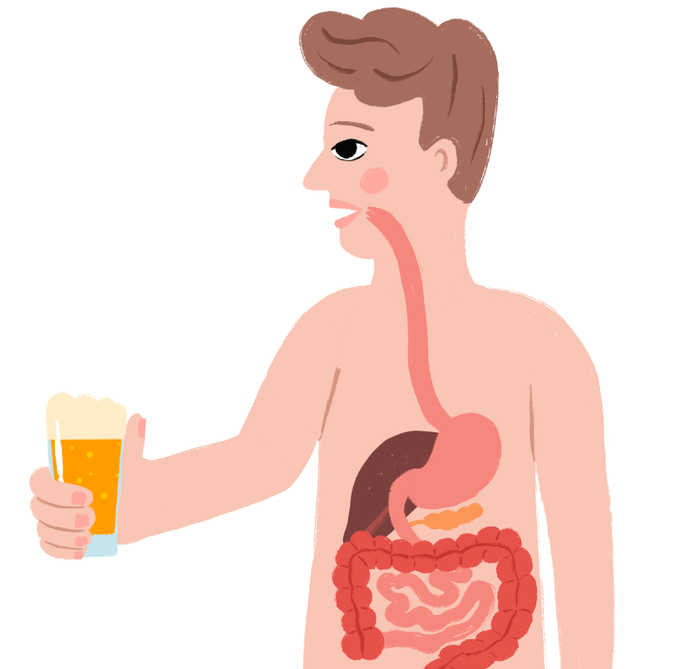Blood alcohol levels
Blood Alcohol Concentration (BAC) measures the amount of alcohol in your bloodstream and it’s what police test for in roadside alcohol breath tests.
A BAC of 0.05% (point 0 five) means that there is 0.05g of alcohol in every 100ml of blood.1
You must be below 0.05% BAC to drive in Australia – although your legal BAC limit could be less, depending on what type of license you have, for example learner drivers must have a 0.00% BAC (see Driving section below).
How do I stay below 0.05?
There’s no amount of drinking that guarantees you’ll stay under 0.05% BAC.
It generally takes the body about 1 hour to process 1 standard drink.
However, two people can drink the same amount of alcohol and have different BACs. This is because there’s a range of individual factors that affect how alcohol is broken down and absorbed.1

What affects my BAC?
Your blood alcohol levels can be influenced by:
- body size
- how much you have eaten
- body fat percentage
- liver health
- age
- sex
- alcohol tolerance
- medications
- the strength of your drinks.
Let’s take a look at each of these factors in more detail, below.
Typically, alcohol concentration is higher in people who are smaller. This means you don’t need many drinks to go over the limit.
Drinking on an empty stomach causes the alcohol to be absorbed into your bloodstream quickly.2 If you don’t eat before drinking, it’s likely you’ll get drunk sooner. But, eating a meal won’t stop you from getting drunk or mean you’re safe to drive.
Our fat cells hold much less water than muscle. This means alcohol isn’t absorbed and sits in your bloodstream until your liver breaks it down. People with higher levels of body fat can have higher levels of BAC.2
Your liver does most of the work breaking down alcohol. Someone with liver disease or liver damage won’t be able to process the alcohol as quickly as people with healthier livers. This means their BAC could be affected.3
As you age, there is a slight decline in how quickly your body processes alcohol. This is because your liver and water content can get smaller as you age. This means alcohol can stay longer in your blood and increase your BAC.2
People assigned female at birth generally have a higher percentage of body fat, lower levels of water in the body, and less of the enzyme that breaks down alcohol, compared to people assigned male at birth.
Lower levels of this enzyme means alcohol will be broken down more slowly and will remain in the blood for longer.3
If you don’t have a lot of experience with drinking, your tolerance will be lower. Your body isn’t used to it and as a result, your BAC could be higher.2
Medication can affect how your body breaks down alcohol. Many medicines need to be broken down by the liver, just like alcohol. If you drink while taking these medications (e.g., contraceptive pills), your liver will be slower at processing alcohol, leading to a higher BAC. If you’re taking any medications talk to your doctor or pharmacist about whether you can drink alcohol.
Not all drinks have the same amount of alcohol in them. The higher the amount of alcohol, the higher your BAC is likely to be. Check out our page on Standard Drinks for more info.
Why does my BAC matter?
Even very small amounts of alcohol can affect your concentration, judgement, and performance. You may feel like you’re ok, but your reaction times will be slower than normal, and your concentration will be reduced.1
This makes it difficult to perform activities that require skill and concentration, or where the safety of others is involved. For example, driving, flying, water sports, skiing, using complex or heavy machinery, or farm machinery.
Drinking and driving
In Australia, it’s illegal to drive if your blood alcohol level is over 0.05%.
If you choose to drink, consider different transport options - public transport, rideshare or organising a friend to be a designated driver.
You must have a 0.00% BAC in most Australian states or territories if you are a:
- learner, provisional, or probationary driver – regardless of age
- truck driver
- bus driver
- driving instructor or if you are supervising a learner driver
- convicted of driving under the influence (DUI).
Even if you’re below 0.05% BAC, your judgement, reaction times and driving skills are impacted.
A BAC 0.05% and above significantly increases the risk of car crash and fatality.4
Drinking and working
Blood alcohol limits apply in jobs like flying planes (e.g. no alcohol within 24 hours of flying), driving public or heavy vehicles, operating commercial ships or machinery. In these jobs, the BAC limit is zero (0.00%). If you’re unsure what your employer’s required BAC limit is, make sure you find out before getting behind the wheel.
Some workplaces implement alcohol and drug testing as a protocol. You can be tested as part of pre-employment screening, at random or following an incident in the workplace.
Workplaces usually only enforce alcohol testing when they are legally obligated to, or where employers, workers and unions agree it’s necessary.
Make sure to read your employment agreement and company policies to check what your obligations and rights are.
How is BAC measured?
Blood alcohol concentration can be measured with a breathalyser, or by analysing a sample of blood, saliva, or urine.
Driver testing
The police do breathalyser tests at random breath testing (RBT) roadblocks, or if they think you might be drink driving.
If you blow 0.05% or over, they’ll need to do a second test at a police station. If your second result is over the legal limit, you can be charged with driving under the influence (DUI).
More information about alcohol and road safety can be found on the VicRoads website.